The Passive Infrared Sensor Market is estimated to be valued at USD 0.8 billion in 2025 and is projected to reach USD 3.3 billion by 2035, registering a compound annual growth rate (CAGR) of 15.0% over the forecast period.
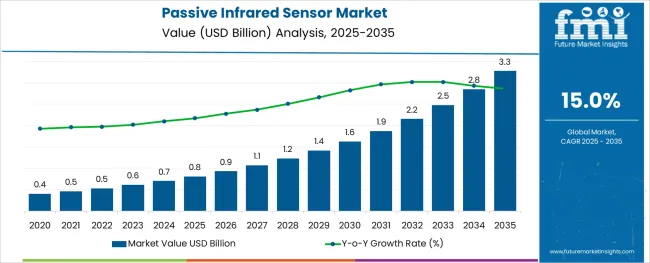
The passive infrared sensor market is progressing steadily due to the growing need for energy-efficient motion detection technologies and contactless sensing applications. Increasing adoption of smart home devices and automation systems has amplified the relevance of passive infrared sensors in enhancing safety and convenience in residential and commercial settings. Consumer demand for reliable motion detection solutions has encouraged manufacturers to develop compact and low-power devices suitable for integration into various consumer electronics and security systems.
At the same time, public awareness of energy conservation has supported the use of passive infrared sensors in lighting controls and smart HVAC systems. As connected devices and automation platforms expand across industries, passive infrared sensors are expected to play a critical role in improving system responsiveness.
Segmental growth is forecasted to be driven by Motion Controllers in the device segment, Long Wave Passive Infrared Sensors in the range segment, and Consumer Electronics as the leading application area.
The market is segmented by Device, Range, and Application and region. By Device, the market is divided into Motion Controller, Smoke Detector, Heat Detector, and Other Devices. In terms of Range, the market is classified into Long Wave Passive Infrared Sensor, Short Wave Passive Infrared Sensor, and Mid Wave Passive Infrared Sensor. Based on Application, the market is segmented into Consumer Electronics, Healthcare, Industrial, Automotive, and Defense and Aerospace. Regionally, the market is classified into North America, Latin America, Western Europe, Eastern Europe, Balkan & Baltic Countries, Russia & Belarus, Central Asia, East Asia, South Asia & Pacific, and the Middle East & Africa.
The market is segmented by Device, Range, and Application and region. By Device, the market is divided into Motion Controller, Smoke Detector, Heat Detector, and Other Devices. In terms of Range, the market is classified into Long Wave Passive Infrared Sensor, Short Wave Passive Infrared Sensor, and Mid Wave Passive Infrared Sensor. Based on Application, the market is segmented into Consumer Electronics, Healthcare, Industrial, Automotive, and Defense and Aerospace. Regionally, the market is classified into North America, Latin America, Western Europe, Eastern Europe, Balkan & Baltic Countries, Russia & Belarus, Central Asia, East Asia, South Asia & Pacific, and the Middle East & Africa.

The Motion Controller segment is expected to contribute 39.6% of the passive infrared sensor market revenue in 2025, maintaining its position as the leading device type. This growth has been supported by the increasing deployment of motion detection in smart lighting systems, security alarms, and consumer appliances. Motion controllers have gained traction for their ability to detect human presence and activity without physical interaction, providing convenience and safety in automated environments.
The expanding adoption of home automation and contactless interfaces has further amplified demand for these devices. Motion controllers are favored for their easy installation, responsive detection, and ability to integrate seamlessly into both standalone devices and larger IoT ecosystems.
With the focus on reducing energy wastage and enhancing user experience, the Motion Controller segment is expected to remain the preferred device type in the market.
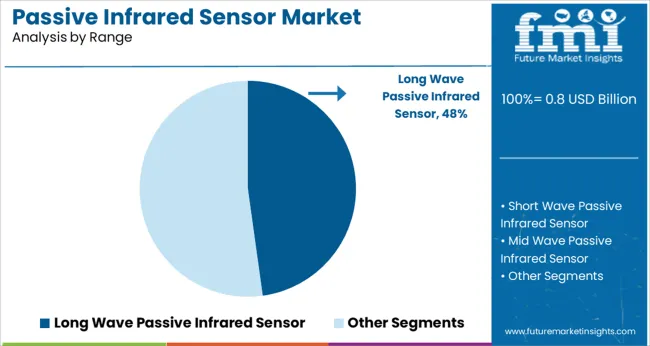
The Long Wave Passive Infrared Sensor segment is projected to account for 47.8% of the passive infrared sensor market revenue in 2025, establishing itself as the dominant range type. The popularity of long wave sensors is rooted in their ability to detect infrared radiation efficiently over a broad area while maintaining stable performance in varying environmental conditions.
Long wave passive infrared sensors have been adopted in a wide range of indoor and outdoor applications due to their enhanced sensitivity to human body heat emissions. Additionally, these sensors have been valued for their reliability in low-light conditions where visual sensors are less effective.
As the need for dependable motion detection grows across multiple industries, the Long Wave Passive Infrared Sensor segment is expected to maintain its strong market presence.
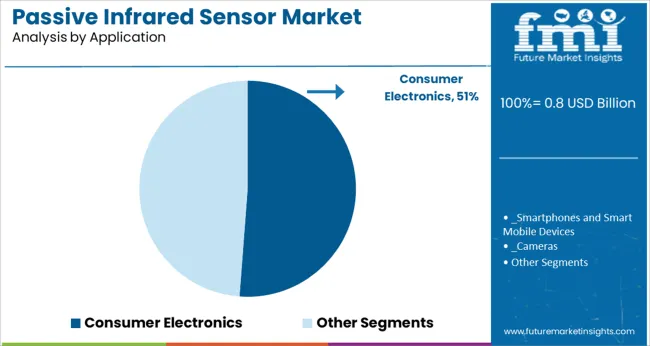
The Consumer Electronics segment is forecasted to capture 51.2% of the passive infrared sensor market revenue in 2025, positioning itself as the largest application category. This growth has been driven by the increasing use of passive infrared sensors in smart TVs, laptops, gaming consoles, and household appliances.
Consumer electronics manufacturers have integrated these sensors to enable energy-saving modes, touchless operation, and motion-based user interfaces. As consumer lifestyles shift toward connected living environments, passive infrared sensors are playing a vital role in creating seamless and intuitive product experiences.
In addition, the widespread use of passive infrared sensors in battery-operated devices highlights their efficiency and compact design. With consumer demand for intelligent and responsive electronics continuing to rise, the Consumer Electronics segment is expected to sustain its lead in the market.
Increasing application area of passive infrared sensors, growing demand for consumer electronics, technological advancements in passive infrared sensors, and rising need for superior security and surveillance solutions are some of the major factors driving the passive infrared sensor market.
During the last few decades, passive infrared sensors have gained immense traction in a wide range of applications due to their ability to detect heat energy radiating from various sources including human beings and animals. They are being extensively in security devices, spectrometers, cameras, fire detection systems, pyrometers, temperature and smoke sensors, medical equipment, and various home appliances.
Passive infrared sensors have become ideal alternatives to various traditional sensors due to their higher accuracy and low consumption features
The robust expansion of residential and commercial sectors due to rapid urbanization and industrialization has provided a strong thrust to the growth of passive infrared sensor market and the trend is likely to continue in the future.
People are spending large amounts to integrate automation in homes and industries. Various modern systems and home appliances such as automated door opening systems, smart lighting systems, motion detectors, fire detection systems etc. use passive infrared sensors.
Increasing incidence of burglaries and security breaches worldwide has necessitated the adoption of advanced security and surveillance systems in residential and commercial buildings. As a result, home owners and security agencies are increasingly deploying cameras and motion sensors at different locations. This is anticipated to create lucrative growth opportunities within the passive infrared sensor market during the forecast period.
Similarly, increasing penetration of 5G technology along with rising integration of infrared cameras in automotive and several other equipment will further expand the size of passive infrared sensor market in the future.
In addition, growing adoption of PIR sensors for motion sensing applications in the gaming sector will further escalate the demand for passive infrared sensors over the assessment period.
Despite its growing popularity, passive infrared sensor market is facing various challenges that are likely to slow down its growth. Some of the major restraints that are currently hindering the growth of passive infrared sensor market are the availability of alternative sensors at lower prices, lower sensitivity and less coverage of passive infrared sensors as compared to microwave sensors and inability of passive infrared sensors to detect objects moving at very slow motion.
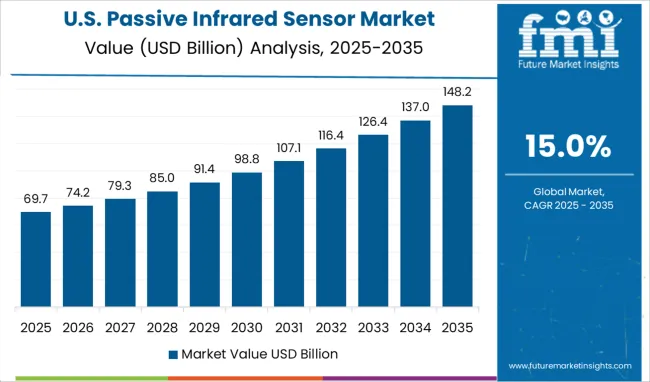
North America is anticipated to continue its dominance in the global passive infrared sensor market during the forecast period, owing to the rising adoption of passive infrared motion sensors in security and surveillance systems, presence of leading market players, and surging demand for motion-controlled devices and equipment.
Countries such as the United States and Canada are witnessing huge demand for passive infrared sensors due to their low cost and energy efficient nature. These sensors are being increasingly integrated in gas selection systems, fire detection systems, security alarm systems and several other motion detection applications.
Moreover, growing popularity of autonomous vehicles and robots will further boost the sales of passive infrared sensors in the region during the forecast period.
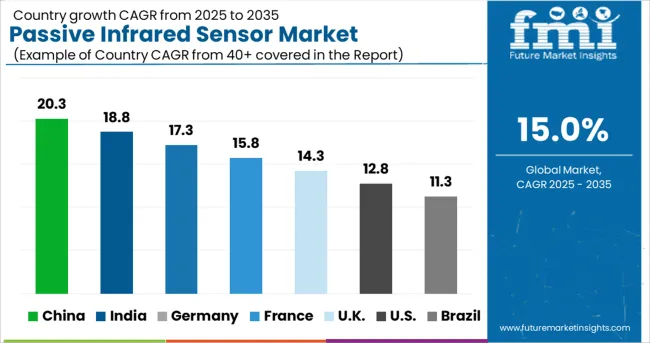
According to Market Insights, the passive infrared sensor market in Asia pacific is slated to grow at the fastest CAGR over the forecast period from 2025 to 2035. Growth in the Asia Pacific market is driven by flourishing consumer electronics and construction industries, availability of low-cost products, and increasing investments in security and surveillance infrastructure.
During the last few years there has been a substantial increase in the demand for passive infrared sensors from electronics, construction and defense sectors across Asia Pacific countries. These passive infrared sensors find their applications in smart lighting systems, security alarms, automated door opening systems, and military equipment.
With increasing spending by people on building smart homes coupled with rising need for advanced detection systems in defense sector, sales of passive infrared sensors are projected to grow at a stellar pace during the forecast period.
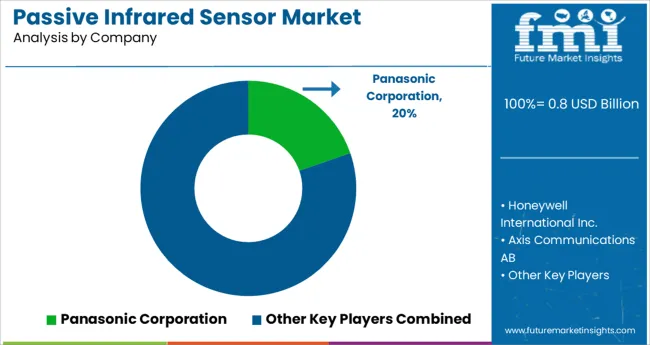
Some of the key participants present in the global passive infrared sensor market include Axis Communications AB, General Dynamics Corporation, Honeywell International Inc, Current Corporation, Atmel Corporation, Cypress Semiconductor, Espon Toyocom Corporation, STMicroelectronics N.V, Nippon Avionics Co., Ltd, Excelitas Technologies Corp., Bosch Security Systems, LLC and Elmos Semiconductor.
The presence of a large number of participants in passive infrared sensor market has made the competition fiercer. In order to stay relevant and gain a competitive edge in the market, key players are using various tactics such as product innovations, cost reduction, partnerships, acquisitions, establishment of bases in attractive regions, and investments in research and development.
| Report Attributes | Details |
|---|---|
| Growth Rate | CAGR of 15% from 2025 to 2035 |
| Base Year for Estimation | 2024 |
| Historical Data | 2020 to 2024 |
| Forecast Period | 2025 to 2035 |
| Quantitative Units | Revenue in USD Million, Volume in Kilotons, and CAGR from 2025 to 2035 |
| Report Coverage | Revenue Forecast, Volume Forecast, Company Ranking, Competitive Landscape, Growth Factors, Trends and Pricing Analysis |
| Segments Covered | Device, Range, Application, Region |
| Regions Covered | North America; Latin America; Western Europe; Eastern Europe; APEJ; Japan; Middle East and Africa |
| Key Countries Profiled | USA, Canada, Brazil, Argentina, Germany, UK, France, Spain, Italy, Nordics, BENELUX, Australia & New Zealand, China, India, ASEAN, GCC, South Africa |
| Key Companies Profiled | Axis Communications AB; General Dynamics Corporation; Honeywell International Inc.; Current Corporation; Atmel Corporation; Cypress Semiconductor; Espon Toyocom Corporation; STMicroelectronics N.V; Nippon Avionics Co., Ltd; ; Bosch Security Systems, LLC; Elmos Semiconductor |
| Customization | Available Upon Request |
The global passive infrared sensor market is estimated to be valued at USD 0.8 billion in 2025.
It is projected to reach USD 3.3 billion by 2035.
The market is expected to grow at a 15.0% CAGR between 2025 and 2035.
The key product types are motion controller, smoke detector, heat detector and other devices.
long wave passive infrared sensor segment is expected to dominate with a 47.8% industry share in 2025.






Our Research Products

The "Full Research Suite" delivers actionable market intel, deep dives on markets or technologies, so clients act faster, cut risk, and unlock growth.

The Leaderboard benchmarks and ranks top vendors, classifying them as Established Leaders, Leading Challengers, or Disruptors & Challengers.

Locates where complements amplify value and substitutes erode it, forecasting net impact by horizon

We deliver granular, decision-grade intel: market sizing, 5-year forecasts, pricing, adoption, usage, revenue, and operational KPIs—plus competitor tracking, regulation, and value chains—across 60 countries broadly.

Spot the shifts before they hit your P&L. We track inflection points, adoption curves, pricing moves, and ecosystem plays to show where demand is heading, why it is changing, and what to do next across high-growth markets and disruptive tech

Real-time reads of user behavior. We track shifting priorities, perceptions of today’s and next-gen services, and provider experience, then pace how fast tech moves from trial to adoption, blending buyer, consumer, and channel inputs with social signals (#WhySwitch, #UX).

Partner with our analyst team to build a custom report designed around your business priorities. From analysing market trends to assessing competitors or crafting bespoke datasets, we tailor insights to your needs.
Supplier Intelligence
Discovery & Profiling
Capacity & Footprint
Performance & Risk
Compliance & Governance
Commercial Readiness
Who Supplies Whom
Scorecards & Shortlists
Playbooks & Docs
Category Intelligence
Definition & Scope
Demand & Use Cases
Cost Drivers
Market Structure
Supply Chain Map
Trade & Policy
Operating Norms
Deliverables
Buyer Intelligence
Account Basics
Spend & Scope
Procurement Model
Vendor Requirements
Terms & Policies
Entry Strategy
Pain Points & Triggers
Outputs
Pricing Analysis
Benchmarks
Trends
Should-Cost
Indexation
Landed Cost
Commercial Terms
Deliverables
Brand Analysis
Positioning & Value Prop
Share & Presence
Customer Evidence
Go-to-Market
Digital & Reputation
Compliance & Trust
KPIs & Gaps
Outputs
Full Research Suite comprises of:
Market outlook & trends analysis
Interviews & case studies
Strategic recommendations
Vendor profiles & capabilities analysis
5-year forecasts
8 regions and 60+ country-level data splits
Market segment data splits
12 months of continuous data updates
DELIVERED AS:
PDF EXCEL ONLINE
Infrared Sensors Market Analysis – Growth & Trends 2025 to 2035
Sensor Data Analytics Market Size and Share Forecast Outlook 2025 to 2035
Sensor Testing Market Forecast Outlook 2025 to 2035
Passive Temperature-Controlled Packaging Solutions Market Size and Share Forecast Outlook 2025 to 2035
Infrared Heating Pad Market Size and Share Forecast Outlook 2025 to 2035
Passive and Interconnecting Electronic Components Market Size and Share Forecast Outlook 2025 to 2035
Sensor Fusion Market Size and Share Forecast Outlook 2025 to 2035
Infrared Thermography Market Size and Share Forecast Outlook 2025 to 2035
Sensor Based Glucose Measuring Systems Market Size and Share Forecast Outlook 2025 to 2035
Sensor Development Kit Market Size and Share Forecast Outlook 2025 to 2035
Sensory Modifier Market Size and Share Forecast Outlook 2025 to 2035
Passive Optical Components Market Size and Share Forecast Outlook 2025 to 2035
Passive Optical Network Market Size and Share Forecast Outlook 2025 to 2035
Passive Fire Protection Market Size and Share Forecast Outlook 2025 to 2035
Passive Fire Protection Materials Market Size and Share Forecast Outlook 2025 to 2035
Infrared Thermometer Market Growth – Trends & Forecast 2025 to 2035
Sensor Bearings Market Insights - Growth & Forecast 2025 to 2035
Sensor Hub Market Analysis - Growth, Demand & Forecast 2025 to 2035
Infrared Search and Track (IRST) Systems Market Analysis - Growth & Forecast 2025 to 2035
Sensor Patches Market Analysis - Growth, Applications & Outlook 2025 to 2035

Thank you!
You will receive an email from our Business Development Manager. Please be sure to check your SPAM/JUNK folder too.
Chat With
MaRIA